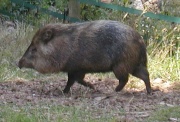Difference between revisions of "Peccary leather"
Jump to navigation
Jump to search
(username removed) |
(username removed) |
||
| Line 8: | Line 8: | ||
== Synonyms and Related Terms == | == Synonyms and Related Terms == | ||
| − | piel de | + | piel de pecarí (Esp.);cuir de pécari (Fr.); pécari (Fr.) |
== Other Properties == | == Other Properties == | ||
| Line 16: | Line 16: | ||
== Authority == | == Authority == | ||
| − | * | + | * Matt Roberts, Don Etherington, ''Bookbinding and the Conservation of Books: a Dictionary of Descriptive Terminology'', U.S. Government Printing Office, Washington DC, 1982 |
| − | * | + | * Edward Reich, Carlton J. Siegler, ''Consumer Goods: How to Know and Use Them'', American Book Company, New York City, 1937 |
| − | * | + | * Website address 1 Comment: American Leather Chemists Association Glossary at www.leatherchemists.org |
[[Category:Materials database]] | [[Category:Materials database]] | ||
Revision as of 06:51, 24 July 2013
Description
The processed skin from a piglike hoofed mammal of the genus Tayassu. Peccary are native to Central and South America (particularly Brazil and Argentina). The skins are usually shaved to produce a thin, light-weight leather for gloves. Peccary is chrome tanned to produce a durable, washable leather.
Synonyms and Related Terms
piel de pecarí (Esp.);cuir de pécari (Fr.); pécari (Fr.)
Other Properties
Bristle holes occur in straight line groups of three.
Authority
- Matt Roberts, Don Etherington, Bookbinding and the Conservation of Books: a Dictionary of Descriptive Terminology, U.S. Government Printing Office, Washington DC, 1982
- Edward Reich, Carlton J. Siegler, Consumer Goods: How to Know and Use Them, American Book Company, New York City, 1937
- Website address 1 Comment: American Leather Chemists Association Glossary at www.leatherchemists.org
